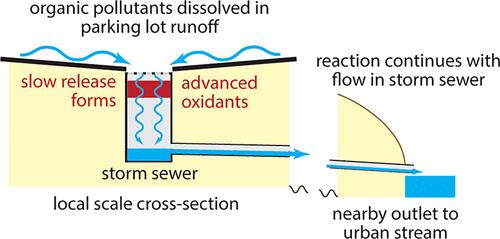Managing Storm Runoff Contamination Using Slow-Release Oxidants: Laboratory Investigations
引用次数: 0
Abstract
Managing contamination by urban storm runoff is challenging because of numerous contaminant sources, the first flush phenomenon, and the fast drainage of stormwater by storm sewers. This paper presents the results of laboratory batch, column, and flow-through tests involving a novel in situ chemical oxidation scheme that combines oxidation and slow-release systems to reduce organic pollutants in urban storm runoff. In batch tests, the persulfate/iron system yielded the best overall removal efficiencies for benzene, toluene, ethylbenzene, xylene, and naphthalene, although the removal rates rapidly decreased after 2 to 3 min due to oxidation of ferrous iron in the solution. Slow-release persulfate (SRP), slow-release hydrogen peroxide (SRH), and slow-release Fe2+ (SRI) were created by dispersing salts in paraffin wax matrices in a cylindrical mold. Results of column tests indicated that the slow-release forms could release oxidants and Fe2+ in a controlled and continuing manner, and the release rates are constrained by the solubility of the dispersed salts and the mixing ratios of the salts and matrices. In the flow-through remedial tests, 89% of naphthalene, ethylbenzene, and xylene, 83% of toluene, and 73% of benzene were removed within 20 min when SRP and SRI were used together. These results suggested that the slow-release oxidants could be installed in multiple storm sewer inlets to rapidly reduce any oxidizable pollutants in storm runoff.

使用缓释氧化剂治理暴雨径流污染:实验室调查
由于污染物来源众多、首冲现象以及下水道对雨水的快速排放,治理城市暴雨径流污染具有挑战性。本文介绍了实验室批量、柱式和流动测试的结果,其中涉及一种新型原位化学氧化方案,该方案结合了氧化和缓释系统,可减少城市暴雨径流中的有机污染物。在批量试验中,过硫酸盐/铁系统对苯、甲苯、乙苯、二甲苯和萘的总体去除率最高,但由于溶液中的亚铁被氧化,去除率在 2 到 3 分钟后迅速下降。缓释过硫酸盐 (SRP)、缓释过氧化氢 (SRH) 和缓释 Fe2+ (SRI) 是通过在圆柱形模具中将盐分散在石蜡基质中制成的。柱状试验结果表明,缓释形式能够以可控和持续的方式释放氧化剂和 Fe2+,而释放速率则受制于分散盐的溶解度以及盐和基质的混合比例。在流动补救试验中,当同时使用 SRP 和 SRI 时,在 20 分钟内可去除 89% 的萘、乙苯和二甲苯、83% 的甲苯和 73% 的苯。这些结果表明,缓释氧化剂可安装在多个暴雨下水道入口处,以快速减少暴雨径流中的任何可氧化污染物。
本文章由计算机程序翻译,如有差异,请以英文原文为准。
求助全文
约1分钟内获得全文
求助全文

 求助内容:
求助内容: 应助结果提醒方式:
应助结果提醒方式:


